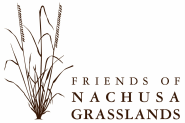Stop 3 — St. Peter Sandstone
The bluffs at Tellabs Savanna offer a stunning topographical relief at Nachusa Grasslands, besides providing a scenic setting with majestic oak trees looming above the colorful flowers of the sand prairie. These outcrops are St. Peter sandstone, sedimentary rocks that were deposited in near–shore or marine environments during the Ordovician period approximately 450 million years ago. At that time, northern Illinois was situated on the continent of Laurentia, in the tropics south of the equator.
|
What is sandstone?
Sandstone is a soft rock made of a hard mineral. You can often crumble sandstone with your bare hand, but if you look at the sand with a hand lens, you see frosted, well–rounded grains of a mineral, quartz, that rates 7 out of 10 on the hardness scale. Because the grains are not very well cemented together, it is very susceptible to erosion by wind, water and biological activity, resulting in the sculpted shapes you see here. The St. Peter Sandstone, being extremely pure quartz, is used for the manufacture of glass, filter and molding sand, as an abrasive, and in the hydrofracturing of oil and gas wells. Journey off the trail to a sandstone outcropping and find . . .
|
St. Peter sandstone forms the exposed bedrock everywhere on Nachusa, with the exception of isolated exposures of dolomite (a type of limestone) at the Carpenter and Hook Larson units, and the bluffs along Babbling Brook in the Orland tract (seen along the Big Jump trail). The St. Peter sandstone forms the knobs on the Hamill–Winter Prairie and the ledges at Shabbona Savanna. It makes up the “castle rocks” that overlook Rock River at the state park near Oregon and the ‘starved rock” at the state park near Ottawa.
CAUTION! Danger of falling. Stay well back from the cliff edges and do not climb on the rock faces, as the sandstone is very soft and can easily crumble under your weight. Feel free to explore the rock face all you like from the bottom, always being aware of the danger of falling rocks or other objects. Stop 4 — Sandstone Bluff Planting Back to Tour Page |
